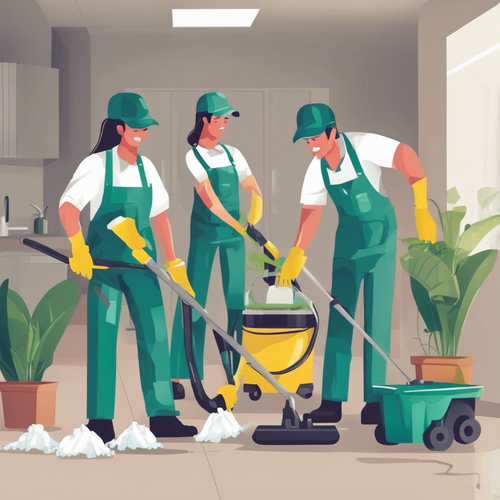Versatile and Virtuous: Educating Your Cleaning Team on Sustainable Practices
Amidst the hustle of bustling cities and the whir of cleaning machines, a hidden transition is taking place in the world of cleaning services—one that holds the potential to transform not just our spaces but the very health of our planet. Educating your cleaning team on sustainable practices is a leap toward an eco-conscious future, yet the challenge remains: How do we transition from merely cleaning to cleaning with a conscience? 🤔
Understanding Sustainability: A Concept Worth Grasping
Sustainability is not simply a buzzword thrown around in green brochures; it’s a structural overhaul of values, behaviors, and practices. It’s about ensuring that every swipe of a mop or spritz of a cleaner doesn’t merely detoxify the surroundings but also diminishes the ecological footprint left in its wake. Think about it—while one might equate cleaning with “sparkle and shine,” true sustainability champions the idea that we can achieve a level of cleanliness that is harmonious with nature, like a well-tuned orchestra performing under a starry sky. 🌌
Educating your team on sustainability means cultivating an understanding of various cleaning techniques and products that balance efficacy with ecological responsibility. But before your team can clean sustainably, they must first understand what sustainability truly means.
A Gentle Antithesis: Traditional vs. Sustainable Practices
Picture this: a traditional cleaning regimen marinated in harsh chemicals, where “sterilized” often translates to “scented with synthetic fragrances.” Now juxtapose that with a sustainable toolkit filled with biodegradable cleaners that whisper promises to the earth rather than shout at it. The irony here is subtle yet biting; we often associate cleanliness with chemicals, while our pursuit should lean toward solutions that honor both hygiene and the health of the planet.
So how can you transition your team from tradition to sustainability?
- Conduct Informative Workshops: Schedule sessions that elucidate the concepts of sustainability in cleaning—discuss the impact of common cleaning agents on our ecosystem versus their environmentally friendly counterparts. Aim for engaging discussions, perhaps with a local environmental expert, allowing your team to interact and foster curiosity. 🔍
- Hands-On Training: Arm your team with eco-friendly products and provide hands-on experience. Show them how to effectively use these greener solutions, highlighting their benefits in comparison to typical products. Just as a musician must practice to master an instrument, so too must your team practice to harmonize with sustainable practices.
- Incentivize Eco-Friendly Choices: Embrace the motivation factor! Perhaps gamify the training by rewarding team members who excel in their sustainable cleaning practices or innovations. Pride in performance is a compelling teacher, igniting passion and sparking creativity. ⚡
Communication: The Bridge Between Theory and Practice
Do you remember the last time you tried to assemble a piece of flat-pack furniture without the instructions? Frustrating, right? In much the same way, communication lays out the instructions for effective teamwork. Clear, open lines of communication help foster an environment where questions flourish, skills grow, and sustainability becomes part of your team’s ethos.
Encouraging Dialogue and Feedback
Set aside time for weekly check-ins to discuss successes, challenges, and innovative ideas related to sustainable practices. Reflective conversations can lead to breakthroughs, revealing how every team member, like the many notes in a symphony, plays a crucial role in creating a harmonious environment.
“Sustainability is not a trend; it’s a commitment to doing things right,” notes environmental advocate Sarah Thorne. “Engaging your team in this mission transforms individuals into stewards of the planet.”
Measuring Progress: Metrics Matter
Like a gardener monitoring sprouting seeds, establish metrics to gauge your team’s progress in adopting sustainable cleaning habits. Track the usage of eco-friendly products versus traditional ones, measure the reduction in waste created during cleaning tasks, and assess overall satisfaction and engagement among team members. Data-driven initiatives not only showcase how far you’ve come but also outline the road ahead.
Beyond the Clean: Cultivating a Culture of Sustainability
Building a team that thrives on sustainable cleaning practices requires more than instruction; it necessitates embedding these values deep within your organizational culture. Share stories of success and collective responsibility—after all, sustainability isn’t just a checklist; it’s a journey, one paved with commitment and mindful choices.
Embrace this philosophy, and watch your team evolve from simply executing cleaning tasks to becoming ambassadors of an eco-friendly routine. When sustainable values are interwoven into the very fabric of your team’s identity, the spark of inspiration ignites. ✨
As we march toward a cleaner planet, it’s essential to recognize that your cleaning team—the unsung heroes of sanitation—can be the champions of sustainable change. Educating them on eco-friendly practices isn’t just about tools and methods; it’s about empowering them to be part of a larger narrative, nurturing a sense of purpose that resonates within their day-to-day mission.
